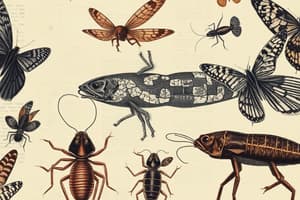Podcast
Questions and Answers
What is a defining characteristic of sponges in the phylum Porifera?
What is a defining characteristic of sponges in the phylum Porifera?
- Symmetrical body structure
- Presence of true tissues and organs
- Ability to move freely in the water
- Absence of a nervous system (correct)
Which reproductive method is NOT associated with sponges?
Which reproductive method is NOT associated with sponges?
- Fragmentation
- Sexual reproduction with flagellated larvae
- Binary fission (correct)
- Asexual reproduction by budding
What structure allows water to flow out of a sponge?
What structure allows water to flow out of a sponge?
- Canals
- Osculum (correct)
- Pores
- Spongocoel
Which of the following describes the body structure of sponges?
Which of the following describes the body structure of sponges?
What type of organism are sponges classified under?
What type of organism are sponges classified under?
Which of the following statements about sponge skeletal structure is true?
Which of the following statements about sponge skeletal structure is true?
How does a sponge obtain nutrition?
How does a sponge obtain nutrition?
Which statement best describes the habitat of sponges?
Which statement best describes the habitat of sponges?
What is the primary function of porocytes in asconoid sponges?
What is the primary function of porocytes in asconoid sponges?
Which canal system type features a spongocoel lined entirely by choanocytes?
Which canal system type features a spongocoel lined entirely by choanocytes?
What differentiates leuconoid sponges from asconoid and syconoid types?
What differentiates leuconoid sponges from asconoid and syconoid types?
What role do choanocytes play in the sponge's aquiferous system?
What role do choanocytes play in the sponge's aquiferous system?
How do syconoid sponges differ from asconoid sponges in structure?
How do syconoid sponges differ from asconoid sponges in structure?
What is the function of the apopyle in syconoid sponges?
What is the function of the apopyle in syconoid sponges?
What characterizes the leuconoid canal system's flagellated surfaces?
What characterizes the leuconoid canal system's flagellated surfaces?
Which of the following statements is true about the dermal pores in syconoid sponges?
Which of the following statements is true about the dermal pores in syconoid sponges?
What is the main function of porocytes in sponges?
What is the main function of porocytes in sponges?
What type of cells are choanocytes primarily responsible for?
What type of cells are choanocytes primarily responsible for?
Gemmules serve which function in sponges?
Gemmules serve which function in sponges?
Which of the following components primarily contributes to the fibrous skeletal structure of a sponge?
Which of the following components primarily contributes to the fibrous skeletal structure of a sponge?
How do most sponges reproduce sexually?
How do most sponges reproduce sexually?
Which statement about archaeocytes is correct?
Which statement about archaeocytes is correct?
Which type of spicules are primarily made of calcium carbonate?
Which type of spicules are primarily made of calcium carbonate?
What is a key feature of sponge asexual reproduction?
What is a key feature of sponge asexual reproduction?
Flashcards are hidden until you start studying
Study Notes
Classification of Invertebrates
- Kingdom Animalia consists of Parazoa and Eumetazoa
- Parazoa includes Phylum Porifera, which encompasses sponges
- Eumetazoa includes animals with true tissues and organs
Characteristics of Phylum Porifera
- Approximately 9,000 sponge species, ranging from 1 cm to 2 m in height; primarily marine, with about 100 freshwater species
- Multicellular organisms lacking true tissues and organs, with various differentiated cell types
- Body structure resembles a sac with pores, canals, and chambers for water transport
- Water enters through pores into the spongocoel and exits via the osculum
- More complex sponges feature branched canals and multiple oscula
Sponge Body Structure
- Body is asymmetrical with two cell layers: outer epidermis and inner endoderm, separated by mesenchyme (mesohyl)
- Mesenchyme contains skeletal elements and cells like archaeocytes and amebocytes
Key Cell Types in Sponges
- Pinacocytes: Thin cells covering the sponge's surfaces
- Porocytes: Regulate water flow via contractile tubes
- Amebocytes (archaeocytes): Digest food and distribute nutrients
- Choanocytes (collar cells): Flagellated cells creating water flow and capturing food particles
Sponge Skeletal Structure
- Skeleton can be fibrous (collagen spongin) or rigid (calcareous or siliceous spicules)
- Silica spicules: Glass-like structures
- Limestone spicules: Composed of calcium carbonate
Reproduction in Sponges
- Most sponges are hermaphrodites, producing both sperm and eggs
- Sexual reproduction involves gametes from choanocytes or amebocytes, with cross-fertilization and development of flagellated larvae
- Asexual reproduction occurs through regeneration and budding from broken fragments
Surviving Harsh Conditions
- Gemmules: Specialized structures containing food and amebocytes, can survive extreme temperatures
- Gemmules can develop into adult sponges when conditions improve
Canal Systems in Porifera
- Sponges have a simple water canal system with tiny openings (ostia) for water intake and larger openings (oscula) for water release
- Three types of canal systems:
- Asconoid: Simplest form with continuous spongocoel lined by choanocytes
- Syconoid: Features simple folding, with distinct choanocyte chambers
- Leuconoid: Most complex, with highly subdivided chambers for increased flagellated surface area
Water Flow Through Sponges
- Water flow mechanisms are essential for feeding, as sponges are suspension feeders, trapping particles from the water passing through their systems
Studying That Suits You
Use AI to generate personalized quizzes and flashcards to suit your learning preferences.




